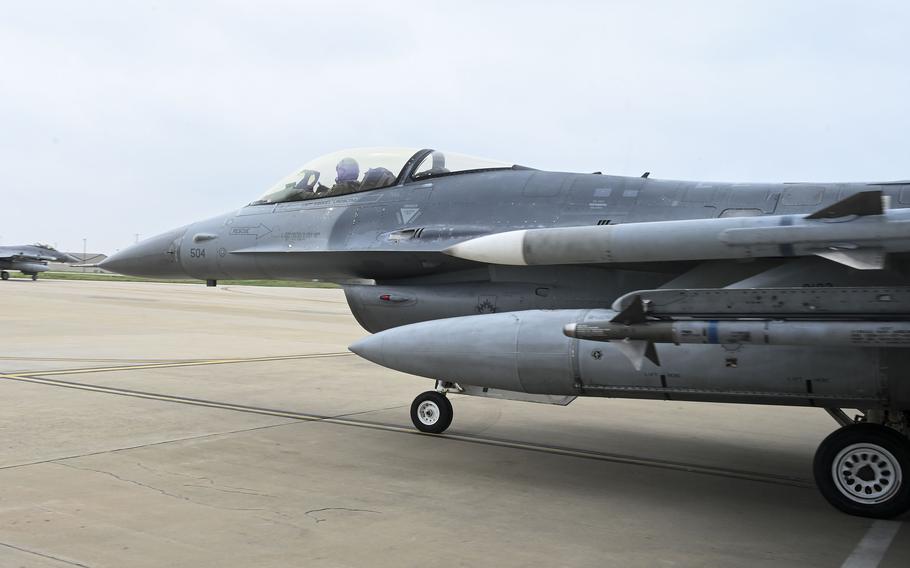
An F-16 Fighting Falcon piloted by the 8th Fighter Wing's commander taxis out of a hangar at Kunsan Air Base, South Korea, on April 23, 2025. (Karissa Dick/U.S. Air Force)
The U.S. 7th Air Force is forming a second “Super Squadron” of 31 F-16 Fighting Falcons at Osan Air Base, its largest installation in South Korea and the one closest to the North Korean border.
The shift will draw down resources at Kunsan Air Base, about 115 miles southwest of Seoul, and means that, eventually, no forces will be assigned to the two fighter squadrons there.
The Air Force began evaluating the concept of a super squadron — which includes one-third more aircraft than standard units — last summer to determine whether it could generate more sorties with fewer resources, 7th Air Force spokeswoman Maj. Rachel Buitrago said by phone Thursday.
In July, nine aircraft and 150 airmen from Kunsan arrived at Osan to establish the first 31-jet squadron.
This month, additional F-16s and roughly 1,000 more airmen will begin the process of relocating from Kunsan to Osan to form the second squadron, Buitrago said.
Assignment notifications will begin in the next couple of weeks and all aircraft and personnel will be in place by October, she said.
While 7th Air Force described the movement of personnel and aircraft as a temporary measure in an April 24 news release, details suggest a more substantial shift.
“This Super Squadron effort demonstrates our steadfast focus on readiness and combat capability to achieve U.S. national security objectives,” 7th Air Force commander Lt. Gen. David Iverson said in the release.
Iverson said the first consolidated unit at Osan has already improved readiness and combat performance, although it has revealed some operational challenges.
“With this success we’re now expanding the scope,” he added.
The restructuring reflects broader U.S. military planning in the Indo-Pacific. While consolidation may enhance peacetime efficiency, big bases like Osan could become vulnerable targets in the event of a conflict, particularly with China, analysts say.
“In the event of conflict, however, they become a bigger target,” Ralph Cossa, former president of the Pacific Forum think tank in Hawaii, said by email Thursday. “Presumably there are also dispersal plans in the event of increased tensions; if not, they just become a more tempting target.”
The new squadrons will optimize combat power at bases in South Korea but that doesn’t preclude repositioning forces if needed, said Dan Leaf, a former deputy commander of what is now called Indo-Pacific Command.
“The ‘super squadrons’ will get the most capability out of available aircraft, personnel, and facilities,” he said by email Thursday.
Kunsan’s 80th and 35th Fighter Squadrons are sending their aircraft to Osan, Buitrago said. Eventually, no forces will be assigned to them.
Despite the drawdown, the 8th Fighter Wing will continue operating Kunsan as a rotational and exercise base, according to the Air Force. The base will maintain flightline operations, war reserve materials and munitions stockpiles at multiple locations across South Korea.
“We acknowledge this is a major shift in how we operate here at Kunsan,” 8th Fighter Wing commander Col. Peter Kasarskis said in the release. “We’ll meet this change with the same warfighter mindset the Wolf Pack has maintained through our history, and strengthen our ability to accept follow-on forces, defend the base and take the fight north.”